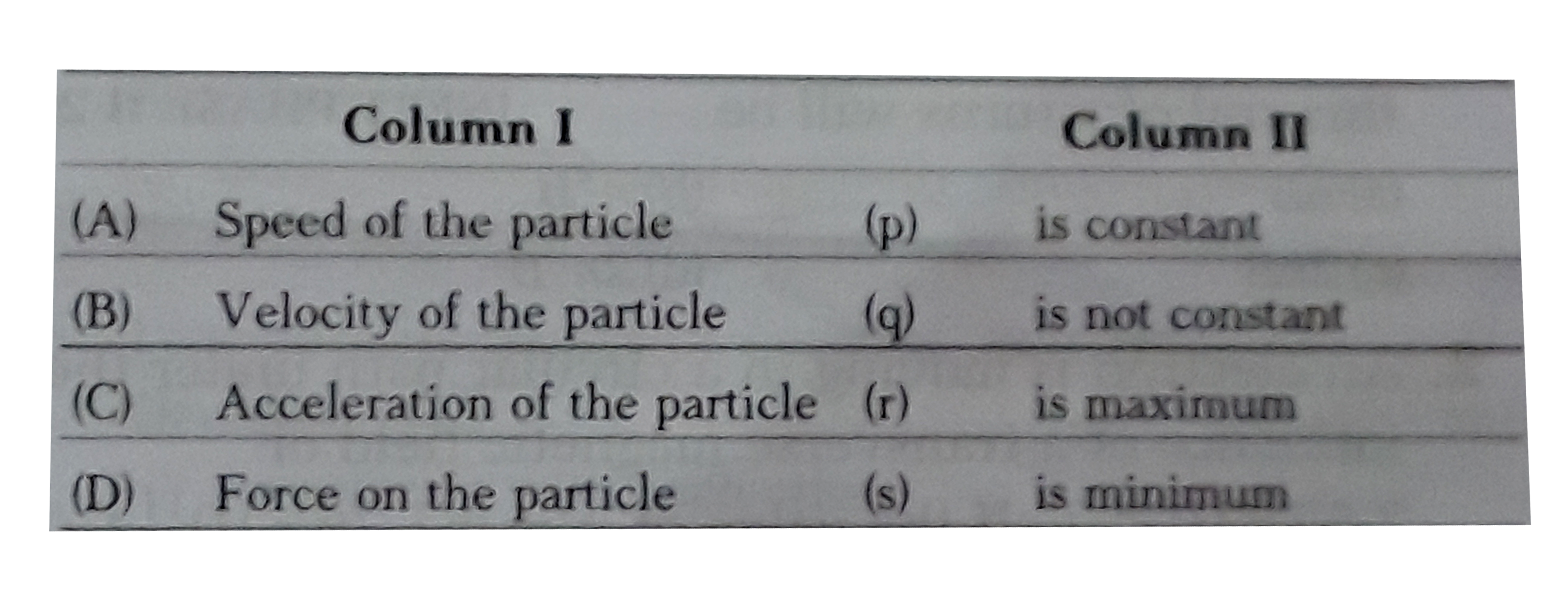Two identical charged particles enter a uniform magnetic field with same speed but at angles 30∘ and 60∘ with field Let a,b and c be the ratio of their time periods, radii and pitches of the helical paths than .
abc=1
abc>1
abc<1
a=bc
The correct Answer is:a,d
To solve the problem, we need to find the ratios of the time periods (A), radii (B), and pitches (C) of the helical paths of two identical charged particles entering a uniform magnetic field at angles of 30° and 60°.
Step 1: Time Period Ratio (A)
The time period (T) of a charged particle moving in a magnetic field is given by the formula:
T=2πmQB
where:
- m = mass of the particle
- Q = charge of the particle
- B = magnetic field strength
Since both particles have the same mass, charge, and magnetic field strength, the time periods for both particles will be equal:
T1=T2
Thus, the ratio of their time periods (A) is:
A=T1T2=1
Step 2: Radius Ratio (B)
The radius (r) of the helical path of a charged particle in a magnetic field is given by:
r=mvsinθQB
For the two angles:
- For θ1=30°
- For θ2=60°
The ratio of the radii (B) is:
B=r1r2=mvsin30°QB÷mvsin60°QB=sin30°sin60°
Calculating the sine values:
- sin30°=12
- sin60°=√32
Thus, the ratio becomes:
B=12√32=1√3
Step 3: Pitch Ratio (C)
The pitch (P) of the helical path is given by:
P=Vcosθ⋅T
Since the time period (T) is the same for both particles, the ratio of the pitches (C) is:
C=P1P2=Vcos30°⋅TVcos60°⋅T=cos30°cos60°
Calculating the cosine values:
- cos30°=√32
- cos60°=12
Thus, the ratio becomes:
C=√3212=√3
Final Calculation: Product of Ratios
Now, we can find the product of the ratios:
A⋅B⋅C=1⋅1√3⋅√3=1
Conclusion
The final result for the product of the ratios A, B, and C is:
A⋅B⋅C=1
The time period (T) of a charged particle moving in a magnetic field is given by the formula:
T=2πmQB
where:
- m = mass of the particle
- Q = charge of the particle
- B = magnetic field strength
T1=T2
Thus, the ratio of their time periods (A) is:
A=T1T2=1
The radius (r) of the helical path of a charged particle in a magnetic field is given by:
r=mvsinθQB
For the two angles:
- For θ1=30°
- For θ2=60°
B=r1r2=mvsin30°QB÷mvsin60°QB=sin30°sin60°
Calculating the sine values:
- sin30°=12
- sin60°=√32
B=12√32=1√3
The pitch (P) of the helical path is given by:
P=Vcosθ⋅T
Since the time period (T) is the same for both particles, the ratio of the pitches (C) is:
C=P1P2=Vcos30°⋅TVcos60°⋅T=cos30°cos60°
Calculating the cosine values:
- cos30°=√32
- cos60°=12
C=√3212=√3
Now, we can find the product of the ratios:
A⋅B⋅C=1⋅1√3⋅√3=1
The final result for the product of the ratios A, B, and C is:
A⋅B⋅C=1
Topper's Solved these Questions
- MAGNETIC EFFECT OF CURRENT AND MAGNETISMBOOK - DC PANDEY ENGLISHCHAPTER - MAGNETIC EFFECT OF CURRENT AND MAGNETISMEXERCISE - Comprehension type Questions
16 Videos
- MAGNETIC EFFECT OF CURRENT AND MAGNETISMBOOK - DC PANDEY ENGLISHCHAPTER - MAGNETIC EFFECT OF CURRENT AND MAGNETISMEXERCISE - Matrix Matching type Questions
12 Videos
- MAGNETIC EFFECT OF CURRENT AND MAGNETISMBOOK - DC PANDEY ENGLISHCHAPTER - MAGNETIC EFFECT OF CURRENT AND MAGNETISMEXERCISE - Only One Option is Correct
45 Videos
- LAWS OF THERMODYNAMICSBOOK - DC PANDEY ENGLISHCHAPTER - LAWS OF THERMODYNAMICSEXERCISE - Level 2 Subjective
18 Videos
- MEASUREMENT AND ERRORSBOOK - DC PANDEY ENGLISHCHAPTER - MEASUREMENT AND ERRORSEXERCISE - Subjective
19 Videos
Similar Questions
Knowledge Check
When a positively charged particle enters a uniform magnetic field with uniform velocity, its trajectory can be
a) a straight line b) a circle c) a helixA(i) onlyB(i) or (ii)C(i) or (iii)Dany one of (i),(ii) and (iii)
A charged particle enters a uniform magnetic field perpendicular to it. The magnetic field
View SolutionIf a charged particle is a plane perpendicular to a uniform magnetic field with a time period T Then
View SolutionThe path of a charged particle moving in a uniform steady magnetic field cannot be a
View SolutionA charged particle enters a unifrom magnetic field with velocity vector at an angle of 45∘ with the magnetic field . The pitch of the helical path followed by the particles is ρ . The radius of the helix will be
View SolutionA proton and anα-particles enters in a uniform magnetic field with same velocity, then ratio of the radii of path describe by them
View SolutionA charged particle enters in a uniform magnetic field perpendicular to it. Now match the following two columns.

View SolutionA charged particle enters a region of uniform magnetic field at an angle of 85∘ to the magnetic line of force. The path of the particle is a circle. Is this statement true or false?
View Solution
